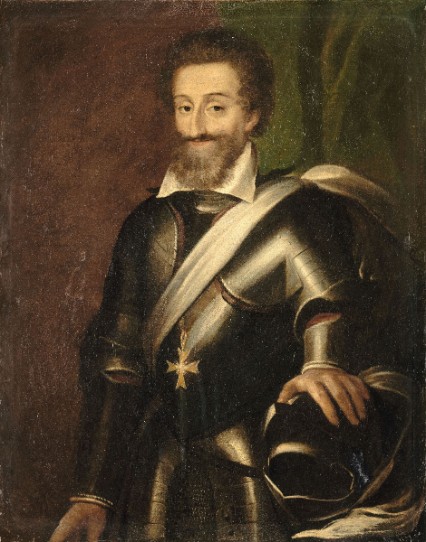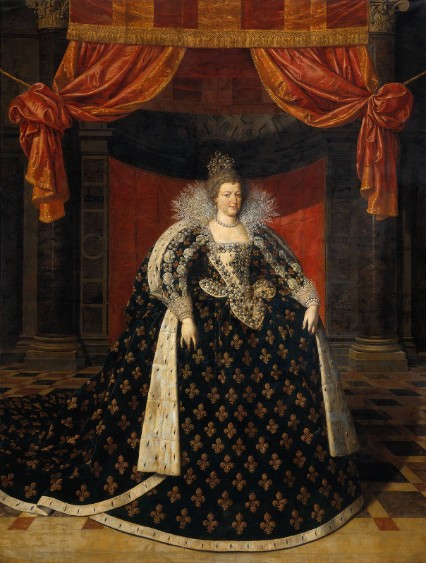Historical Context
The beginning of the seventeenth-century found France embroiled in religious turmoil between the Catholics and the Protestants. The Edict of 1606, ratified by Parlement, prompted "clerical reform in France," which Henri IV supported. However, the religious radicalism that Henri IV tried to eradicate ended up causing his death. Henri IV was assassinated in 1610, leaving his wife as Regent for his young son. After coming of age in 1614, Louis XIII relieved his mother of her Regent duties. Louis XIII's ascension to power brought Cardinal Richelieu into greater authority, effectively ruling France. Cardinal Richelieu's decisions governed France and brought added power to France through several victories in battle. Throughout Louis XIII's reign, Cardinal Richelieu's power and authority grew, stretching even into Louis XIV's reign. With the death of Louis XIII in 1643, his wife, Anne of Austria ruled as Regent for their five-year-old son. Anne ruled for eight years before Louis XIV came of age in 1651. One of Anne's accomplishments was the appointment of Mazarin as a minister alongside Cardinal Richelieu. In 1651, Louis XIV ascended the throne, beginning his seventy-two year reign and reshaping France through his absolute rule.
The Bourbon Dynasty:
In 1600, Henry IV wed Marie de Medici, who then bore him six children, including the Dauphin (the future heir to the throne), Louis. After facing and resolving religious turmoil, Henri IV, sought to boost the economy through agriculture and commercial industry through trade with other European countries. Henri IV managed to keep the peace between the Protestants and the Catholics through treaties and alliances. However, in 1610, Henri IV was assassinated by a Catholic fanatic. Henri IV's death left his wife, Marie de Medici as Regent for his young son. Much of Henri IV's reign was marked by numerous military campaigns. In the portrait to the right, Henri IV is decked out in simple armor. What message does the simplicity of the portrait send to the onlooker? Does this portrayal exude the strength of the monarchy? | King Henri IV (1589-1610)  |
Queen Marie de Medici (Regent 1610-1617)  Frans Pourbus II, ca. 1600-1642, Rijks Museum | With the surprise death of her husband in 1610, Marie de Medici became Regent for her young son, Louis XIII. Marie set about reversing Henri IV's foreign and religious policies, invoking the ire of the French government. When Louis XIII came of age in 1614, Marie refused to relinquish her power. However, her son seized control and exiled her. Marie tried to wrest back control and was unsuccessful. Marie's exiling did not mean that she stayed out of Louis XIII's life, in fact, she persuaded her son to appoint Cardinal Richelieu as his chief minister. In the end, Richelieu became Marie's enemy, rejecting her friendship in favor of Louis XIII's. After losing her power, she left France, never to return. In the portrait to the left, Marie de Medici is dressed completely opposite from her husband in the painting above. Not only is Marie dressed in immense splendor, she also exhibits the French royal family's symbol: the fleur-de-lys. Note also the color of Marie's dress. The color blue has royal significance. Her dress is trimmed in ermine, a fur used explicitly for the royalty. How does this image contribute to her idea of herself, especially in her position as Regent? Does this image exude Marie's right to rule? |
Louis XIII officially became the King of France in 1614 when he came of age, thus ending Marie de Medici's reign as Regent. However, the Queen Regent retained her position of power three years after Louis XIII became King. Marie de Medici's continued control caused strain on her relationship with her son, as he wanted full power. Louis XIII ultimately exiled his mother to Blois, where she unsuccessfully plotted rebellions against her son to recover the throne. In 1621, Louis XIII faced a Huguenot rebellion, eventually leading to a truce between the insurgents and the defenders. Also in 1621, Louis XIII's closest minister died, causing Louis XIII to install his mother's former favorite, Cardinal Richelieu as his top adviser, despite Louis XIII's suspicion due to the former closeness of Richelieu and Marie de Medici. Louis XIII suffered from poor health and mental instability, which limited his ability to rule effectively, thus empowering Cardinal Richelieu. Richelieu's considerably power in government prompted the monarchy to consolidate the its authority and deconstruct the Catholic Spanish and Hapsburg power in Europe. As a result, The Thirty Years War (1618-1648) widened the disparity between the Catholics and the Protestants, eventually fostering a power feud between the Hapsburgs and the Bourbons. In 1635, France declared war on Spain, leading to a victory for France. In 1638, Louis XIII's wife, Anne of Austria, gave birth to the Dauphin, the future Louis XIV. Towards the end of Louis XIII's reign, his dependence on Richelieu grew, especially due to the number of victories against France that Richelieu had overseen. Louis XIII died of tuberculosis in 1643, leaving Anne of Austria as Regent for the five-year old Louis XIV. Curiously, Louis XIII is garbed in Spanish-looking attire, even though France and Spain had a tense relationship. In this portrait, Louis XIII is not dressed in traditionally royal attire, although his outfit is still full of symbolism and luxury. The baton in Louis XIII's hand symbolizes military authority, which was a major factor in Louis XIII's reign due to the number of military campaigns launched. Other monarchs throughout Europe utilized the symbolism of the baton in royal portraits as well. Along with the baton, Louis XIII is clad in armor, another explicit symbol of Louis XIII's military might. Does this symbolism contribute to the image of the king to the audience? How is the military portrayal more effective than the ermine-trimmed robes and overt finery? Is this image effective? | King Louis XIII (1610-1643)  |
Queen Anne of Austria (Regent 1643-1651)  Peter Paul Rubens, ca. 1601-1666, Louvre | With the death of Louis XIII in 1643, his wife, Anne of Austria became Regent for her young son, now Louis XIV. During Anne's short rule as Regent, she was determined not to give back power to the French nobles, as she had wanted her son to inherit as an absolute monarch. As a result, a revolt, known as The Fronde, broke out against the monarchy, culminating with rebels breaking into the royal family's palace at the Louvre. This event would later lead to Louis XIV's distaste for Paris and the subsequent movement of the royal court to the palace of Versailles. Another accomplishment of Anne's was the appointment of Jules Mazarin as a minister in addition to Richelieu. When Louis XIV came of age in 1651, Anne relinquished her control. As with Marie de Medici, Anne of Austria was a foreign transplant in France. Both Anne and Marie brought the styles of their respective countries with them, blending with the French style. Anne, like Marie, utilizes the color blue to acknowledge her position in the royal family. Note the finery and detail in her outfit. How does the background suggest a return to classical ideals? Does the background even send that message? Does the fact that Anne is sitting instead of standing suggest her role as Regent? |
Louis XIV's father died in 1643, leaving his mother, Anne of Austria, as Regent. Because of The Fronde, Louis XIV's distaste for Paris led to the refurbishment of the hunting château, Versailles, which was located twenty-five kilometers outside of Paris. The royal court moved to Versailles in 1682. The Palace of Versailles was a symbol of the absolute power of Louis XIV, thereby the monarchy. Located throughout the palace were motifs of the Greek god, Apollo, and of the sun; both of which were used to symbolize the reign of France and Europe's new Sun King. Religiously, Louis XIV was a hardcore Catholic and revoked the Edict of Nantes, the legislation that Henri IV signed to protect the Protestants in France. Louis XIV worked with Cardinal Richelieu and Mazarin to turn France into a self-reliant country in terms of economy. The three set about reducing foreign imports and increasing exports through the adoption of foreign industry in France. For example, Venice had a monopoly on the art of mirror-making. Therefore, France set about learning the craft in order to both wrest the business (thereby wealth) from Venice and to boost French economy. Louis XIV's ultimate goal was to become the center of culture and style from which the rest of Europe and its tributaries could draw upon, hence the sun motif. Never doubting his divine right to rule, Louis XIV became his own chief minister after the death of Cardinal Mazarin in 1661. Louis XIV worked closely with Jean-Baptist Colbert in order to accomplish his financial goals for France. Due to this linkage, Louis XIV became a renown patron the the arts and sciences, including architecture, art, sculpture, theater, and the founding of the Royal French Academies. Although Louis XIV patronized the arts, he spent quite a bit of the money in the treasury on foreign wars. France gained land, such as Flanders, and allies, such as England, throughout his war career. The grandeur and opulence of Louis XIV's reign began to decline towards the dawn of the seventeenth-century and to the end of his reign in 1715. The portrait to the right depicts Louis XIV towards the beginning of his reign, before much of his economic and stylistic revolution. Does this portrait exude the sense of royalty seen in a later portrait of him? While not decked out in the traditional symbols of royalty, Louis XIV is still finely dressed, with embroidered and embellished fabric, along with the color blue. Remember that France still segregated social classes through limitations on colors worn by different people of varying status. | King Louis XIV (1643-1715)  Charles Le Brun, ca. 1643-1715 |
~All dates are dates of reign Format: Title (if available), Artist(s), Date, Current Location